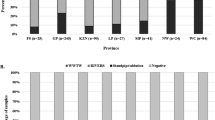Summary
Hepatitis C virus (HCV) and hepatitis E virus (HEV) are the principal causes of non-A, non-B hepatitis worldwide, and in Turkey one-third of the cases of acute hepatitis are non-A, non-B. To explore the epidemiology of HCV in Turkey (including the association of HCV with HEV), a seroprevalence study of HCV was conducted. Sera from residents from five distinct regions of the country were tested for antibodies to HCV (anti-HCV) and HEV (anti-HEV). Anti-HCV was detected in 21 (1.5%) of 1,374 persons and was more common in residents over 54 years of age (p=0.02), with less than primary education (p=0.013), more than two children (p=0.003), and who lived in the regions of Ayvalik (p=0.046) or Trabzon (p=0.038) compared to Istanbul. Anti-HCV was marginally associated with anti-HEV, which was found in 5.9% of residents. However, this association was lost after controlling for age and education (p=0.225). HCV infection occurs in all regions of Turkey and is more common in persons who are older and of low socioeconomic status. As resources permit, efforts to reduce the transmission of HCV in Turkey (such as screening blood donations for anti-HCV) are indicated.
Zusammenfassung
Das Hepatitis C Virus (HCV) und das Hepatitis E Virus (HEV) sind weltweit die Haupterreger der Non-A, Non-B-Hepatitis: In der Türkei sind ein Drittel der Fälle von akuter Hepatitis Non-A, Non-B. Eine Seroprävalenzstudie für HCV wurde durchgeführt, um die Epidemiologie des HCV, einschließlich der Assoziation von HCV und HEV in der Türkei zu ermitteln. Seren von Einwohnern von fünf verschiedenen Regionen des Landes wurden auf Antikörper gegen HCV (anti-HCV) und HEV (anti-HEV) getestet. Bei 21 von 1.374 Personen (1,5%) wurde anti-HCV nachgewiesen. Der Test war häufiger positiv bei Einwohnern über 54 Jahre (p=0,02), bei Personen, die unter dem Hauptschul-Bildungsstand waren (p=0,013), bei Familien mit mehr als zwei Kindern (p=0,003) und bei Personen, die in der Region von Ayvalik (p=0,046) oder Trabzon (p=0,038) wohnen — verglichen mit Einwohnern von Istanbul. Zwischen anti-HCV und anti-HEV bestand eine marginale Assoziation, die bei 5,9% der Einwohner aufgedeckt wurde. Die HCV-Infektion tritt in allen Regionen der Türkei auf und ist häufiger bei älteren Personen und bei niedrigem sozio-ökonomischen Status. Für die Einschränkung der HCV-Übertragung in der Türkei sollten — falls Mittel verfügbar sind — Schritte wie das anti-HCV Screening von Blutspenden durchgeführt werden.
Similar content being viewed by others
References
Esteban, J. I., Esteban, R., Viladomiu, L., Lopez-Talavera, J. C., Gonzalez, A., Hernandez, J. M., Roget, M., Vargas, V., Genesca, J., Buti, M., Guardia, J. Hepatitis C virus antibodies among risk groups in Spain. Lancet ii (1989) 294–296.
Alter, H. J., Purcell, R. H., Shih, J. W., Melpolder, J. C., Houghton, M., Choo, Q., Kuo, G. Detection of antibody to hepatitis C virus in prospectively followed transfusion recipients with acute and chronic non-A, non-B hepatitis. N. Engl. J. Med. 321 (1989) 1494–1500.
Alter, M. J., Margolis, H. S., Krawczynski, K., Judson, F. N., Mares, A., Alexander, W. J., Hu, P. Y., Miller, J. K., Geber, M. A., Sampliner, R. E., Meeks, E., Beach, M. J. The natural history of community acquired hepatitis C in the United States. N. Engl. J. Med. 327 (1992) 1899–1905.
CDC: Public Health Service interagency guidelines for screening blood, plasma, organs, tissue and semen for evidence of hepatitis B and C. MMWR 40 (No. RR-4) 1–23.
Simonetti, R. G., Camma, C., Fiorello, F., Cottone, M., Rapicetta, M., Marino, L., Fiorentino, G., Craxi, A., Ciccaglione, A., Buiseppetti, R., Stroffolini, T., Pagliaro, L. Hepatitis C virus infection as a risk factor for hepatocellular carcinoma in patients with cirrhosis. Ann. Intern. Med. 116 (1992) 97–102.
Donahue, J. G., Nelson, K. E., Munoz, A., Vlahov, D., Rennie, L. L., Taylor, E. L., Saah, A. J., Cohn, S., Odaka, N. J., Farzadegan, H. Antibody to hepatitis C virus among cardiac surgery patients, homosexual men, and intravenous drug users in Baltimore, Maryland. Am. J. Epidemiol. 134 (1991) 1206–1211.
Brettler, D. B., Alter, H. J., Dienstag, J. L., Forsberg, A. D., Levine, P. H. Prevalence of hepatitis C virus antibody in a cohort of hemophilia patients. Blood 76 (1990) 254–256.
Menitove, J. E., Richards, W. A., Destree, M. Early US experience with anti-HCV kits in blood donors. Lancet 336 (1990) 244–245.
Yenen, O. S., Badur, S. Prevalence of antibodies to hepatitis C virus in blood donors and risk groups in Istanbul, Turkey. Eur. J. Clin. Microbiol. Infect. Dis. 10 (1991) 93–94.
Köksal, I., Biberoglu, K., Biberoglu, S., Koc, F., Ayma, Y., Aker, F., Köksal, H. Hepatitis C virus antibodies among risk groups in Turkey. Infection 19 (1991) 228–229.
Cakaloglu, Y., Okten, A., Kaymakoglu, S., Badur, S., Yalcin, S. Prevalence of antibody to hepatitis C virus in cryptogenic, hepatitis B-related, and chronic alcoholic liver disease, and in blood donors in Turkey. Turk. J. Med. Biol. Res. 3 (1992) 53–57.
Thomas, D. L., Mahley, R. W., Badur, S., Palaoglu, K. E., Quinn, T. Q. Epidemiology of hepatitis E virus infection in Turkey. Lancet 341 (1993) 1561–1562.
Donahue, J. G., Munoz, A., Ness, P. M., Brown, D. E., Yawn, D. H., McAllister, H. A., Reitz, D. E., Nelson, K. E. The declining risk of post-transfusion hepatitis C virus infection. N. Engl. J. Med. 327 (1992) 369–373.
Weinstock, H. S., Bolan, G., Reingold, A. L., Polish, L. B. Hepatitis C virus infection among patients attending a clinic for sexually transmitted diseases. JAMA 269 (1993) 392–394.
Balayan, M. S., Andjaparidze, A. G., Savinskaya, S. S., Keyiladze, E. S., Braginsky, D. M., Savinov, A. P., Poleschuk, V. F. Evidence for a virus in non-A, non-B hepatitis transmitted via the fecal-oral route. Intervirology 20 (1983) 23–31.
Author information
Authors and Affiliations
Rights and permissions
About this article
Cite this article
Thomas, D.L., Quinn, T.C., Mahley, R.W. et al. The epidemiology of hepatitis C in turkey. Infection 22, 411–414 (1994). https://doi.org/10.1007/BF01715499
Received:
Accepted:
Issue Date:
DOI: https://doi.org/10.1007/BF01715499




